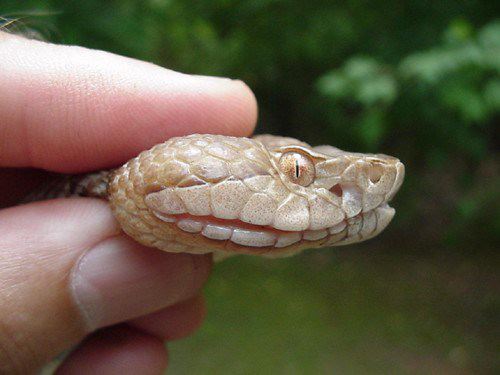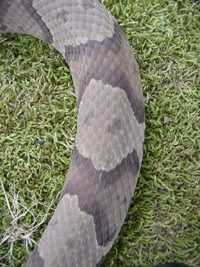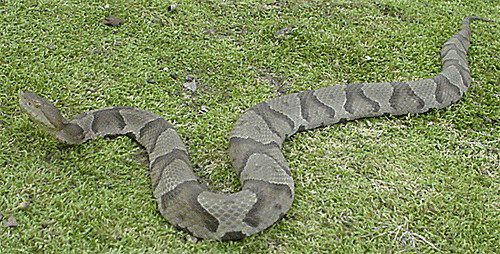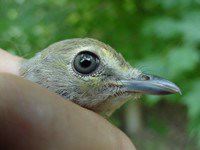
Photo © Hilton Pond Center
- Since 1982 at Hilton Pond Center, we've identified 19 species of reptiles, including five kinds of turtles, six lizards, and eight snakes. Of the latter, Black Ratsnakes (Elaphe obsoleta) are by far the most common--including the three-footer that climbs up and down the Flowering Dogwood (Cornus florida) just outside our office window. We suspect other reptilian species occur at the Center, but many are nocturnal or secretive and not likely to be spotted among the plentiful vegetation. That's why it's always exciting--and a bit startling--to come across our second-most-frequently-seen snake, the Copperhead (above).
 Every one of the Copperheads (s) observed at Hilton Pond Center has been crawling on a grassy path or an open lawn. Although we've undoubtedly passed near dozens more through the years, their tan bodies with chestnut hourglass markings are perfect camouflage against dead leaves. Copperheads are locally common and responsible for the majority of poisonous snake bites in the Piedmont, but they are perhaps the least toxic of all venomous snakes in the Carolinas, and their bite is almost never fatal to humans. Individual Copperheads are often docile and non-aggressive; in fact, one summer while looking skyward at birds, Center executive director Bill Hilton Jr. accidentally stepped on a massive four-foot Copperhead stretched across the trail and got no response from the snake at all! Every one of the Copperheads (s) observed at Hilton Pond Center has been crawling on a grassy path or an open lawn. Although we've undoubtedly passed near dozens more through the years, their tan bodies with chestnut hourglass markings are perfect camouflage against dead leaves. Copperheads are locally common and responsible for the majority of poisonous snake bites in the Piedmont, but they are perhaps the least toxic of all venomous snakes in the Carolinas, and their bite is almost never fatal to humans. Individual Copperheads are often docile and non-aggressive; in fact, one summer while looking skyward at birds, Center executive director Bill Hilton Jr. accidentally stepped on a massive four-foot Copperhead stretched across the trail and got no response from the snake at all!

Photo © Hilton Pond Center
- A close-up view of the Copperhead's face reveals a small pit behind each nostril that is heat-sensitive and allows the snake to find warm-blooded prey in the dark; this specialized structure makes the Copperhead a "pit viper"--a family of North American snakes that includes rattlesnakes and the Water Moccasin, or Cottonmouth. Although rattlers--especially Timber Rattlesnakes (Crotalus horridus) and Pygmy Rattlesnakes (Sistrurus miliarius)--do occur in the Carolina Piedmont, there are no authenticated records for Water Moccasins (Agkistrodon piscivorus) very far from the Coastal Plain, and any "Piedmont cottonmouth" is almost certainly a large non-poisonous watersnake (Nerodia spp., formerly Natrix). Another venomous species in the Carolinas, the Eastern Coral Snake (Micrurus fulvius), occurs in the sandy Coastal Plain but not in the Piedmont.
- All pit vipers also have elliptical (slit) pupils that become larger and rounder in darkness, thus allowing more light to enter. They also have in each upper jaw quadrant a single fang that folds as the snake's mouth closes. When the pit viper strikes, its hollow fangs straighten, and venom--a form of modified saliva--is injected into the prey. Pit vipers are primarily hemotoxic--their venom destroys muscle and blood cells--but they also appear to have at least some neurotoxin that affects nerves and can paralyze cardiac and respiratory function.
- Copperheads are ovoviviparous; i.e., the egg membrane ruptures inside the mother and the young are born alive. In late summer, females bear up to a dozen or so eight-inch snakelets that resemble the adult--except that they have bright fluorescent yellow-green tails! Copperheads of all ages eat large insects and small amphibians, reptiles, mammals, and birds--which they just swallow whole, right after the venom has taken its toll.
If you enjoy "This Week at Hilton Pond," please help Support
Hilton Pond Center for Piedmont Natural History.
It's painless, and YOU can make a difference!
You may wish to consult our Index of all nature topics covered since February 2000.
|




